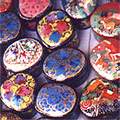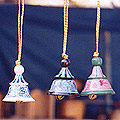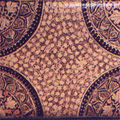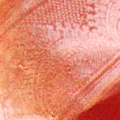The minutely detailed craft, which – according to national awardee Mohd. Shafi Nagoo – requires ‘education, patience, and eyesight’ is incomparable for the fine painting work done on objects made of papier mache – all the painting, including filling in of colours, is done with a brush made of a single cat hair. Shafi Nagoo uses the Hindi proverb ‘Sui se kua khodna (Using a needle point to dig a well) to convey the amount of delicate and patient work that underlines the artwork.
Objects made of papier mache are built of paper pulp, or layers of paper pulp – hence the name papier mache or ‘mashed paper’. However, the craft of papier mache refers, in practice, here actually to the technique of surface decoration rather than the creation of the body of the object.
The craft was originally known in Kashmir ‘by its Iranian name viz. Kar- i-Qalamdani’ (Qalamdani = pen-case). It is believed that in the initial stages the craft was restricted to the ornamentation of pen-cases. The craft was also known as ‘Kar-I-Munaqqash, which…could be because it was used for ornamenting smooth surfaces made of paper pulp or layers of polished paper’.
HISTORY & TRADITIONS
The craft is supposed to have come from Kashmir from Central Asia, under King Zain- Ul-Abidin, who invited accomplished artists from Central Asia. According to Shafi Nagoo the craft can be traced in Kashmir to an Iranian by the name of Torab who came to Kashmir. The craft is found only in Kashmir district and is practised only by the Shia Muslim community.
The craft was originally known in Kashmir ‘by its Iranian name viz. Kar- i-Qalamdani’ (Qalamdani = pen-case). It is believed that in the initial stages the craft was restricted to the ornamentation of pen-cases. The craft was also known as ‘Kar-I-Munaqqash, which…could be because it was used for ornamenting smooth surfaces made of paper pulp or layers of polished paper’.
Minimal decoration on early book jackets evolved to ornamentation of a range of products, from bangles to lamp-stands, screens, and cabinets, and – under Mughal patronage – to palanquins, ceilings, bedsteads, doors, and windows.

PROCESS
Waste paper is soaked in water (usually in a large cauldron or pot) for about a week; the soaked paper is then beaten with a big hammer and/or ground in a maorata made of limestone. The paper is then mixed with starch made from the water of boiled rice and gum. The process is different in Kashmir from that in other European countries in that in Kashmir the paper is not pulped fully.
The craftspersons use wooden or clay moulds of all the product prototypes. Initially the moulds were made of clay, usually by the artisan himself. Nowadays, the craftspersons procure the moulds – made of wood and brass. There is also a group of people known as sakta makers who ‘make papier mache objects out of pulp and sell these objects to the “naqqash” or papier mache painter…’. Pulp is applied on the mould and, when dry, removed from the mould – thus the same mould can be reused.
The mould is first covered with ordinary paper, after which a layer (or several) of the prepared paper is patted on to it. This is then dried for a couple of days, after which it is cut and the mould extracted. The thickness of the box (or any other product) is created by using several layers of prepared paper. The article removed from the mould is re-joined with the help of saresh, a thick glue made of natural gum and mishri or sugar. After the joint is made secure, the object is gently rubbed with a wooden file called kathwa. Chuna paste (made from ‘kurkut’ or pumice stone) is applied to smoothen the surfaces of the product, which is often wrapped in gummed turban cloth to strengthen it.
The background colour (zamin) is applied on to the cloth. The designs are drawn from nature and memory; they represent creativity and improvisation. Shafi Nagoo says that he has ‘thousands of designs’ in ‘his head’. He draws them – in free-hand – with a pencil on to the prepared surface. Traditionally, however, the ornamentation was done by making the outlines in zarda or yellow colour and the spaces required for floral work were stained with astar consisting of gypsum mixed with glue. A brush is used to colour the sketch, and then subsequently to create the required effects – like shading. All the painting, including filling in of colours, is done with a brush made of a single cat hair.

PRODUCTS
The ‘box’ is the ubiquitous papier mache product. Round, square, rectangular, and oval boxes, in all sizes, lined with velvet on the inside (or painted with black lacquer) are typical. The boxes can be small (perhaps 5 cm3 ) or extremely large, over 25 cm in length.
A varied new product range is now available, including both utilitarian and decorative items. Letter-racks, candle-stands, coasters, napkin-rings, small bowls, trays, small screens, and jars are some of the ‘daily-use’ products that are commonly made and which sell well. Ornamental fish, elephants, and ducks in various sizes and colours being made by Shafi Nagoo as decorative pieces. Small bells and chimes in an array of colours also sell well.

DESIGNS
Depictions of flora and fauna, along with geometrical patterns – especially as borders – are predominant. Motifs range from depictions of flowers, bordered by geometrical designs, to depictions of branching trees, with flowers and fruit. The natural history of Kashmir is frequently depicted, be it in the prolific use of the chinar tree and leaf as decorative motifs, or in the representation of snow-capped peaks, of antelope, deer, and horses, and of hunting scenes with rajas mounted on horses.
Well-known patterns include the hazara (thousand flowers) and the gul ander gul (flower within flower). The hazara aims to depict every conceivable flower, while in gul ander gul, the flowers are depicted in bunches, one behind/within another. The badam tarah represents the mango-shaped badam (almond) motif. The chinar is depicted often, as is the zanbuk grass, in silver or gold, with colourful birds displayed in it. The yarkand design is very elaborate – built up in spirals, with gold roseattes radiating from various centres. It is further embellished by laying white flowers over gold scroll work. There is also scroll work, involving gold lettering on a cream-white background, with a border in bright colours.
Other common floral motifs include: the zard gulab or yellow rose (this displays flowers like the panchbargi, sossan, kaldar, nyo, and the yellow rose, from which it derives its name); the phulai, a patterns consisting of tiny flowers in bunches; tcheen, a pattern made of small and big flowers of apple trees; and darzaland, a multi-coloured pattern in which are depicted bunches of small and large flowers.
The kingfisher and the bulbul are the birds most frequently depicted. Human and animal figures are depicted in thematic representations, such as ‘shikar gali‘ or hunting ground; ‘jungle tarah‘ or jungle scene; and in polo and court scenes sourced from (Mughal) miniature paintings.
The borders are usually made by repeating a particular motif, often a flower selected from the hazara.

COLOURS
Traditionally colours derived from minerals and plants and vegetables were used. Some pigments were imported – white lead from Russia, lapiz lazuli (for the preparation of ultramarine) from Yarkhand, a particular clay used for making browns from Armenia. However, there were adequate indigenous sources of colour also: red was obtained from saffron; also from cochineal, rosewood, and local forest wood named lin. Brown and black were obtained from green and dried walnut skins. Black could be obtained from iron filings, and by burning raw pomegranate peels. Bright yellows were produced from a flower by the name of guli-ksu and a wild plant known as weflangil. Violets and blues were obtained from indigo.
Today, however, organic colours have been replaced by synthetic paints – poster and water colours bought in the market.
The artisans use both gold leaf and gold paint. The gold leaf is introduced through an extremely dexterous process: the design is outlined in glue/gum; a patch of gold leaf is placed on the gummed area; the leaf adheres to the design outlined in glue/gum, creating a design in gold leaf; the remaining leaf falls off. The use of gold leaf patches thus involves a lot of wastage. Any pattern that is depicted only in gold is known as sonposh.
The painter surface is coated with a transparent lacquer made from the badam tree. This protects the painting. The drying process has to be natural; no heat is applied.

CONTEMPORARY SITUATION
Shafi Nagoo’s son says that though he helps his father in fairs and exhibitions, yet he will not learn the (till now) hereditary family craft. Laying his bets on education, he says unblinkingly that the time for earning a livelihood from practising this craft is long gone. His father agrees with him: ‘We are sitting on the pavement and selling our craft…. There is no respect and no recognition…and no money…. It is only foreigners who are willing to pay for the craftsmanship….Indian buyers are constantly haggling about the price and [in the process] demeaning our craft.’
Shafi Nagoo says that sales used to be excellent good before the terrorism and political turmoil in the Kashmir area destroyed tourism, particularly foreign tourism.



